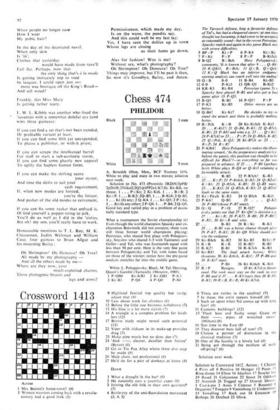Chess 474
PHILIDOR
A. Benedek (Hon. Men., BCF Tourney 119). White to play and mate in two moves; solution next week.
Solution to No. 473 (Promislo 3R2bN/SpPB/ 2p2b1R/2NlIcn2/2Q5/p1PP2n1/K7/8): Kt-K6, no threat. 1 PxKt; 2 Kt-Kt6.,1 . BxB; 2 Kt x P. 1 . B-K2; 2Q-B5. 1 . B-Kt4; 2 Q-B5. 1 . . . Kt (6) any; 2 Q-K4. 1 . Kt-Q5; 2 P x Kt. 1 . Kt (4) any other; 2 P-Q4. 1 . . . P-B4; 2 Q-Q5. Good key and varied play in a problem of essen- tially standard type.
What a tournament the Soviet championship is! Even though the world champion Spassky and ex- champion Botwinnik did not compete, there were still three former world champions playing; Petrosian, who shared first place with Polugaiev- sky, Smyslov who shared 3-5 with Taimanov and Geller—and Tal, who was fourteenth equal with less than 50 per cent. Here is the very fine game between Polugaievsky and Tal, with notes based on those of the winner; notice how the pre-game analysis stretches far into the middle game.
White, L. Polugaievsky. Black, M. Tal. Opening, Queen's Gambit (Tarrasch). (Moscow, 1969).
1 P-QB4 Kt-KB3 2 Kt-QB3 P-K3 3 Kt-B3 P-Q4 4 P-Q4' P-B4 The Tarrasch defence, long a favourite defence of Ted's, has had a chequered career; at one time thought too loosening, it had come to be accepted as reasonably sound—but in the recent Petrosian/ Spassky match and again in this game Black met with severe difficulties.
5 BP xP KtxP 6 P-K4 KtxKt 7 PxKt PxP 8 PxP B-Kt5ch
9 B-Q2 BxBch Here Polugaievsky comments, 'It is known that after 9 . . . Q-R4; 10 R-QKtI, Bx Bch; 11 QxB, QxQch: 12 K x Q Black has an inferior endgame; opening analysis can reach well into the ending!
10 QxB 0-0 11 B-B4 Kt-B3 12 0-0 P-Kt3 13 QR-Q1 B-Kt2
14 KR-K1 Kt-R4 Petrosian (game 5) v Spassky here played R-B1 and also got a bad game after 15 P-Q5.
15 B-Q3 R-BI 16 P-Q5! PxP 17 P-K5Kt-B5 Other moves are no better.
18 Q-B41 Kt-Kt7 He decides to try to stand the attack and there is probably nothing better.
19 B xPch K x B 20 Kt-Kt5ch K-Kt3
20 . . . K-Ktl?; 21 Q-R4, R-K1; 22 Q-R7ch, K-B1; 23 P-K6! and wins e.g. 23 . . . Q x Kt?:
24 P-K7ch! or 23 . . . P xP; 24 Q-R8ch, K-B2; 25 Q xPch, K-Q3; 26 Kt-B7ch or 23 . . . RxP; 24 RxR!
21 P-KR4! Here Polugaievsky makes the illum- inating remark, 'In the preparatory analysis (i.e. before the game), this position was thought to be difficult for Black'!—so everything so far was prepared in advance. If 21 . . . P-B4 (perhaps best) White plays R-Q4 or Q-Kt3 retaining a formidable attack.
21 ... R-B5 22 P-R5ch! K-R3
22 . . . KxP; 23 P-Kt4ch, K-R3 ; 24 Q-R2ch!, K x Kt; 25 Q-R5ch, K-B5 ; 26 Q-B5 mate.
23 . . . K-Kt3; 24 Q-B5ch, K-R3; 25 Q-R7ch! leads to the same mate.
23 Kt x Pd.ch K-R2 24 Q-B5ch K-Ktl
25 P-K6! Q-B3 25 . . . Q-K2; 26 P-R6! (threat P-R7 mate).
26 Q x Q P x Q 27 R-Q2? Polugai- evsky points out that 27 Kt-Q6! is decisive e.g.
27 . . . Kt x R; 28 P-K7!, R-B8; 29 P-R6!!, R-RI ; 30 Kt x 8 and wins.
27 ... R-B3 28 Rx Kt R-Kl 28 . . . B-B1 was a better chance though after 29 P-K7, R-KI ; 30 Kt-Q8 White should just win the endgame.
29 Kt-R6ch K-R2 30 Kt-B5 R(1) x P 31 R xR R x R 32 R-B2! R-B3 33 R-K2! B-B1 34 R-K7ch K-R1
35 Kt-R4! The final attack begins; White threatens 36 Kt-Kt6ch, K-Kt I ; 37 P-R6 and 38 R-Kr7 mate.
35 ... P-B4 36 Kt-Ktbch K-Ktl 37 R xP Resigns. 38 Kt-K7ch is threat- ened. The rook must stay on the rank to slop P-R6 and if 37 . . . R-K3 (say) then 38 R-R8, R-KI ; 39 Rx B, Rx R; 40 Kt-K7ch.


































 Previous page
Previous page